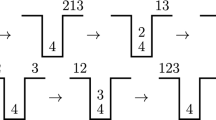Abstract
A synchronization problem in cellular automata has been known as the Firing Squad Synchronization Problem (FSSP), where the FSSP gives a finite-state protocol for synchronizing a large scale of cellular automata. A quest for smaller state FSSP solutions has been an interesting problem for a long time. It has been shown by Balzer (Inf Control 10:22–42, 1967), Sanders (in: Jesshope, Jossifov, Wilhelmi (eds) Proceedings of the VI international workshop on parallel processing by cellular automata and arrays, Akademie, Berlin, 1994) and Berthiaume et al. (Theoret Comput Sci 320:213–228, 2004) that there exists no 4-state FSSP solution in arrays and rings. The number four is the state lower bound in the class of FSSP protocols. Umeo et al. (Parallel Process Lett 19(2):299–313, 2009), by introducing a concept of full versus partial FSSP solutions, provided a list of the smallest 4-state symmetric powers-of-2 FSSP protocols that can synchronize any one-dimensional (1D) ring cellular automata of length \(n=2^{k}\) for any positive integer \(k \ge 1\). Afterwards, Ng (in: Partial solutions for the firing squad synchronization problem on rings, ProQuest Publications, Ann Arbor, MI, 2011) also added a list of asymmetric FSSP partial solutions, thus completing the 4-state powers-of-2 FSSP partial solutions. A question whether there are any 4-state partial solutions for ring lengths other than powers-of-2 has remained open. In this paper, we answer the question by providing a new class of the smallest symmetric and asymmetric 4-state FSSP protocols that can synchronize any 1D ring of length \(n=2^{k}-1\) for any positive integer \(k \ge 2\). We show that the class includes a rich variety of FSSP protocols that consists of 39 symmetric and 132 asymmetric solutions, ranging from minimum to linear synchronization time. In addition, we make an investigation into several interesting properties of those partial solutions, such as swapping general states, transposed protocols, a duality property between them, and an inclusive property of powers-of-2 solutions.














Similar content being viewed by others
References
Balzer, R.: An 8-state minimal time solution to the firing squad synchronization problem. Inf. Control 10, 22–42 (1967)
Berthiaume, A., Bittner, T., Perković, L., Settle, A., Simon, J.: Bounding the firing synchronization problem on a ring. Theoret. Comput. Sci. 320, 213–228 (2004)
Gerken, H.D.: Über Synchronisationsprobleme bei Zellularautomaten. Diplomarbeit, Institut für Theoretische Informatik, Technische Universität Braunschweig, pp. 1–50 (1987)
Goto, E.: A minimal time solution of the firing squad problem. Dittoed course notes for Applied Mathematics 298 (with an illustration in color), Harvard University, pp. 52–59 (1962)
Kamikawa, N., Umeo, H., Fujita, G.: A class of 4-state array synchronizers. Annual Report for Institute of Informatics, University of Osaka Electro-communication, draft version, (2020) (to appear)
Kutrib, M., Malcher, A.: Fast cellular automata with restricted inter-cell communication: computational capacity. IFIP TCS 151–164 (2006)
Kutrib, M., Malcher, A.: On one-way one-bit O (One)-message cellular automata. Electron. Notes Theor. Comput. Sci. 252, 77–91 (2009)
Kutrib, M., Malcher, A.: Cellular automata with sparse communication. Theoret. Comput. Sci. 411(38–39), 3516–3526 (2010)
Mazoyer, J.: A six-state minimal time solution to the firing squad synchronization problem. Theoret. Comput. Sci. 50, 183–238 (1987)
Moore, E.F.: The firing squad synchronization problem. In: Moore, E.F. (ed.) Sequential Machines, Selected Papers, pp. 213–214. Addison-Wesley, Reading, MA (1964)
Ng, W.L.: Partial solutions for the firing squad synchronization problem on rings, pp. 1–363. ProQuest publications, Ann Arbor, MI (2011)
Sanders, P.: Massively parallel search for transition-tables of polyautomata. In: Jesshope, C., Jossifov, V., Wilhelmi, W. (eds.) Proceedings of the VI International Workshop on Parallel Processing by Cellular Automata and Arrays, pp. 99–108. Akademie, Berlin (1994)
Umeo, H., Kamikawa, N.: A design of real-time non-regular sequence generation algorithms and their implementations on cellular automata with 1-bit inter-cell communications. Fundam. Inf. 52(1–3), 257–275 (2002)
Umeo, H., Kamikawa, N., Yunès, J.-B.: A family of smallest symmetrical four-state firing squad synchronization protocols for ring arrays. Parallel Process. Lett. 19(2), 299–313 (2009)
Umeo, H., Kamikawa, N., Fujita, G.: The smallest FSSP partial solutions for one-dimensional ring cellular automata: symmetric and asymmetric synchronizers. In: Proceedings of the 15th International Colloquium on Theoretical Aspects of Computing, ICTAC 2018, LNCS 11187, pp. 455–471 (2018)
Umeo, H., Kamikawa, N., Fujita, G.: A quest of the smallest 4-state partial solutions for rings. Annual Report for Institute of Informatics, University of Osaka Electro-communication (2020) (to appear)
Umeo, H., Yanagihara, T.: A smallest five-state solution to the firing squad synchronization problem. In: Proceedings of 5th International Conference on Machines, Computations, and Universality, MCU 2007, LNCS 4664, pp. 292–302 (2007)
Vollmar, R.: Some remarks about the efficiency of polyautomata. Int. J. Theoret. Phys. 21(12), 1007–1015 (1982)
Waksman, A.: An optimum solution to the firing squad synchronization problem. Inf. Control 9, 66–78 (1966)
Wolfram, S.: A new kind of science, p. 1280. Wolfram Media Inc., Champaign (2002)
Yunès, J.B.: A 4-states algebraic solution to linear cellular automata synchronization. Inf. Process. Lett. 19(2), 71–75 (2008)
Acknowledgements
A part of this work was supported by JSPS 16K00026. The authors would like to thank reviewers for many helpful comments and suggestions to improve the paper.
Author information
Authors and Affiliations
Corresponding author
Additional information
Publisher's Note
Springer Nature remains neutral with regard to jurisdictional claims in published maps and institutional affiliations.
A preliminary version of this work appeared at 15th International Colloquium on Theoretical Aspects of Computing, ICTAC 2018, held on 16–19, October, 2018, in Stellenbosch, South Africa.
Rights and permissions
About this article
Cite this article
Umeo, H., Kamikawa, N. & Fujita, G. A new class of the smallest FSSP partial solutions for 1D rings of length \(n=2^{k}-1\). Acta Informatica 58, 427–450 (2021). https://doi.org/10.1007/s00236-020-00391-6
Received:
Accepted:
Published:
Issue Date:
DOI: https://doi.org/10.1007/s00236-020-00391-6




